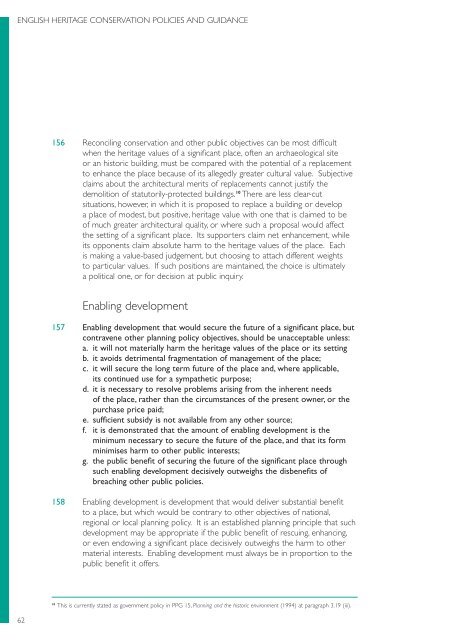Conservation Principles, Policies and Guidance - English Heritage
Conservation Principles, Policies and Guidance - English Heritage
Conservation Principles, Policies and Guidance - English Heritage
Create successful ePaper yourself
Turn your PDF publications into a flip-book with our unique Google optimized e-Paper software.
ENGLISH HERITAGE CONSERVATION POLICIES AND GUIDANCE<br />
62<br />
156 Reconciling conservation <strong>and</strong> other public objectives can be most difficult<br />
when the heritage values of a significant place, often an archaeological site<br />
or an historic building, must be compared with the potential of a replacement<br />
to enhance the place because of its allegedly greater cultural value. Subjective<br />
claims about the architectural merits of replacements cannot justify the<br />
demolition of statutorily-protected buildings. 10 There are less clear-cut<br />
situations, however, in which it is proposed to replace a building or develop<br />
a place of modest, but positive, heritage value with one that is claimed to be<br />
of much greater architectural quality, or where such a proposal would affect<br />
the setting of a significant place. Its supporters claim net enhancement, while<br />
its opponents claim absolute harm to the heritage values of the place. Each<br />
is making a value-based judgement, but choosing to attach different weights<br />
to particular values. If such positions are maintained, the choice is ultimately<br />
a political one, or for decision at public inquiry.<br />
Enabling development<br />
157 Enabling development that would secure the future of a significant place, but<br />
contravene other planning policy objectives, should be unacceptable unless:<br />
a. it will not materially harm the heritage values of the place or its setting<br />
b. it avoids detrimental fragmentation of management of the place;<br />
c. it will secure the long term future of the place <strong>and</strong>, where applicable,<br />
its continued use for a sympathetic purpose;<br />
d. it is necessary to resolve problems arising from the inherent needs<br />
of the place, rather than the circumstances of the present owner, or the<br />
purchase price paid;<br />
e. sufficient subsidy is not available from any other source;<br />
f. it is demonstrated that the amount of enabling development is the<br />
minimum necessary to secure the future of the place, <strong>and</strong> that its form<br />
minimises harm to other public interests;<br />
g. the public benefit of securing the future of the significant place through<br />
such enabling development decisively outweighs the disbenefits of<br />
breaching other public policies.<br />
158 Enabling development is development that would deliver substantial benefit<br />
to a place, but which would be contrary to other objectives of national,<br />
regional or local planning policy. It is an established planning principle that such<br />
development may be appropriate if the public benefit of rescuing, enhancing,<br />
or even endowing a significant place decisively outweighs the harm to other<br />
material interests. Enabling development must always be in proportion to the<br />
public benefit it offers.<br />
10 This is currently stated as government policy in PPG 15, Planning <strong>and</strong> the historic environment (1994) at paragraph 3.19 (iii).

















